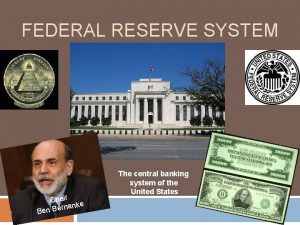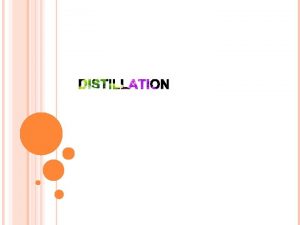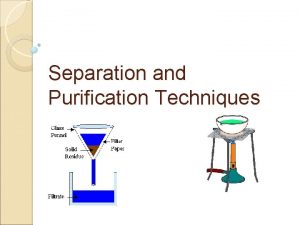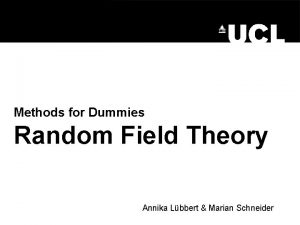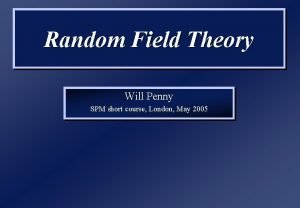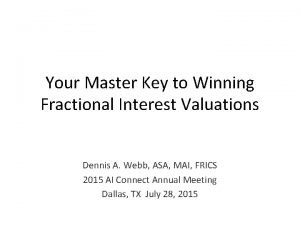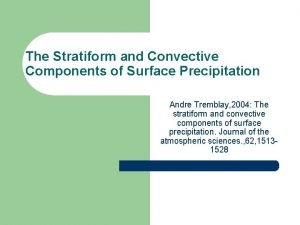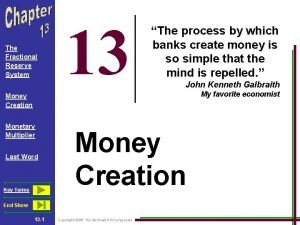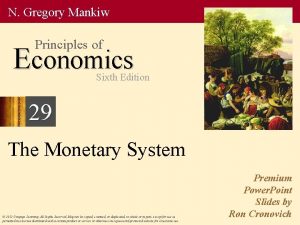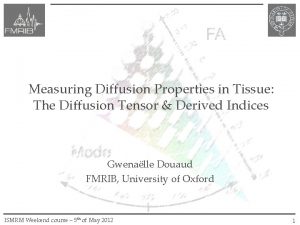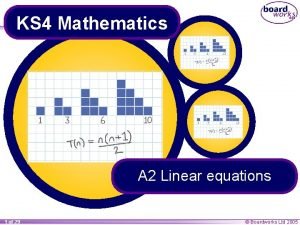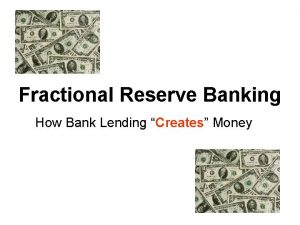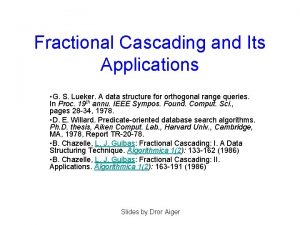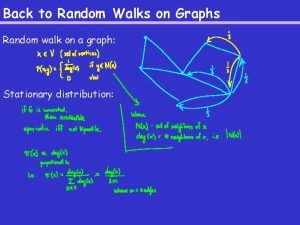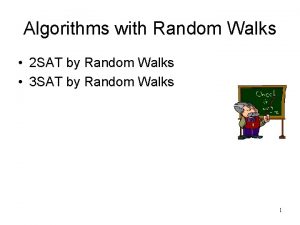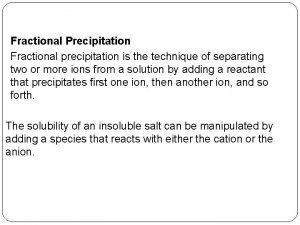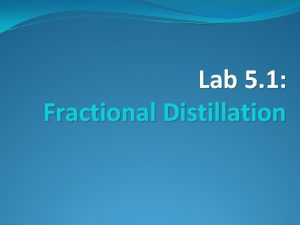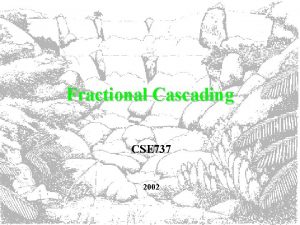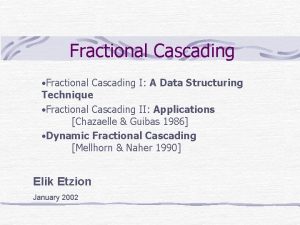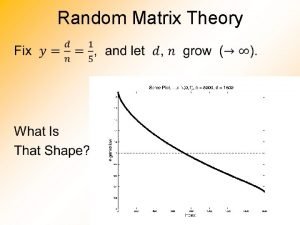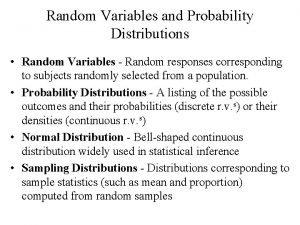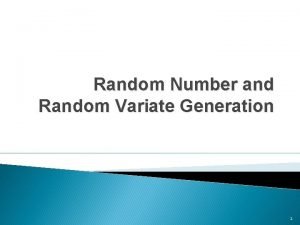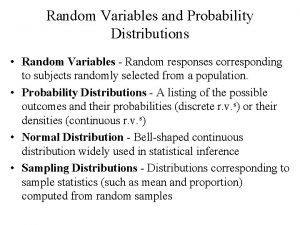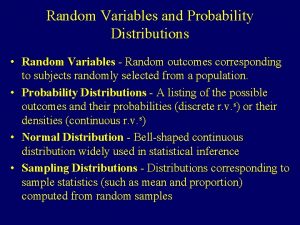Continuoustime random walks and fractional calculus Theory and




























- Slides: 28

Continuous-time random walks and fractional calculus: Theory and applications Enrico Scalas (DISTA East-Piedmont University) www. econophysics. org DIFI Genoa (IT) 20 October 2004

Summary • Introduction to CTRW and applications to Finance • Applications to Physics • Conclusions

Introduction to CTRW and applications to Finance

1999 -2004: Five years of continuous-time random walks in Econophysics Enrico Scalas (DISTA East-Piedmont University) www. econophysics. org WEHIA 2004 - Kyoto (JP) 27 -29 May 2004

Summary • Continuous-time random walks as models of market price dynamics • Limit theorem • Link to other models • Some applications

Tick-by-tick price dynamics

Theory (I) Continuous-time random walk in finance (basic quantities) : price of an asset at time t : log price : joint probability density of jumps and of waiting times : probability density function of finding the log price x at time t

Theory (II): Master equation Permanence in x, t Jump into x, t Marginal jump pdf Marginal waiting-time pdf In case of independence: Survival probability

Theory (III): Limit theorem, uncoupled case (I) (Scalas, Mainardi, Gorenflo, PRE, 69, 011107, 2004) Mittag-Leffler function This is the characteristic function of the log-price process Subordination: see Clark, Econometrica, 41, 135 -156 (1973). subordinated to a generalised Poisson process.

Theory (IV): Limit theorem, uncoupled case (II) (Scalas, Gorenflo, Mainardi, PRE, 69, 011107, 2004) Scaling of probability density functions Asymptotic behaviour This is the characteristic function for the Green function of the fractional diffusion equation.

Theory (V): Fractional diffusion (Scalas, Gorenflo, Mainardi, PRE, 69, 011107, 2004) Green function of the pseudo-differential equation (fractional diffusion equation): Normal diffusion for =2, =1.

Continuous-time random walks (CTRWs) (Scalas, Gorenflo, Luckock, Mainardi, Mantelli, Raberto QF, submitted, preliminary version cond-mat/0310305, or preprint: www. maths. usyd. edu. au: 8000/u/pubs/publist. html? preprints/2004/scalas-14. html) Mathematics Diffusion processes Fractional calculus CTRWs Compound Poisson processes as models of high-frequency financial data Subordinated processes Physics Normal and anomalous diffusion in physical systems Cràmer-Lundberg ruin theory for insurance companies Finance and Economics

Example: The normal compound Poisson process ( =1) Convolution of n Gaussians The distribution of x is leptokurtic

Generalisations Perturbations of the NCPP: • general waiting-time and log-return densities; (with R. Gorenflo, Berlin, Germany and F. Mainardi, Bologna, Italy, PRE, 69, 011107, 2004); • variable trading activity (spectrum of rates); (with H. Luckock, Sydney, Australia, QF submitted); • link to ACE; (with S. Cincotti, S. M. Focardi, L. Ponta and M. Raberto, Genova, Italy, WEHIA 2004!); • dependence between waiting times and log-returns; (with M. Meerschaert, Reno, USA, in preparation, but see P. Repetowicz and P. Richmond, xxx. lanl. gov/abs/cond-mat/0310351); • other forms of dependence (autoregressive conditional duration models, continuous-time Markov models); (work in progress in connection to bioinformatics activity).

Applications • Portfolio management: simulation of a synthetic market (E. Scalas et al. : www. mfn. unipmn. it/scalas/~wehia 2003. html). • Va. R estimates: e. g. speculative intra-day option pricing. If g(x, T) is the payoff of a European option with delivery time T: (E. Scalas, communication submitted to FDA ‘ 04). • Large scale simulations of synthetic markets with supercomputers are envisaged.

Empirical results on the waiting-time survival function and their relevance for market models (Anderson-Darling test) (I) Interval 1 (9 -11): 16063 data; 0 = 7 s Interval 2 (11 -14): 20214 data; 0 = 11. 3 s Interval 3 (14 -17): 19372 data; 0 =7. 9 s where 1 2 … n A 12= 352; A 22= 285; A 32= 446 >> 1. 957 (1% significance)

Empirical results on the waiting-time survival function and their relevance for market models (Anderson-Darling test) (II) • Non-exponential waiting-time survival function now observed by many groups in many different markets (Mainardi et al. (LIFFE) Sabatelli et al. (Irish market and ), K. Kim & S. -M. Yoon (Korean Future Exchange)), but see also Kaizoji and Kaizoji (cond-mat/0312560) • Why should we bother? This has to do both with the market price formation mechanism and with the bid-ask process. If the bid-ask process is modelled by means of a Poisson distribution (exponential survival function), its random thinning should yield another Poisson distribution. This is not the case! • A clear discussion can be found in a recent contribution by the GASM group. • Possible explanation related to variable daily activity!

Applications to Physics


Problem • Understanding the scaling of transport with domain size has become the critical issue in the design of fusion reactors. • It is a challenging task due to the overwhelming complexity of magnetically confined plasmas that are typically in a turbulent state. • Diffusive models have been used since the beginning.

Focus and method • Tracer transport in pressure-gradientdriven plasma turbulence. • Variations in pressure gradient trigger instabilities leading to intermittent and avalanchelike transport. • Non-linear equations for the motion of tracers are numerically solved. • The pdf of tracer position is non-Gaussian with algebraic decaying tails.


Solution I • There is tracer trapping due to turbulent eddies. • There are large jumps due to avalanchelike events. • These two effects are the source of anomalous diffusion.

Solution II • Fat tails (nearly three decades)

Fractional diffusion model

Model I

Model II

Conclusions • CTRWs are suitable as phenomenological models for high-frequency market dynamics. • They are related to and generalise many models already used in econometrics. • They are suitable phenomenological models of anomalous diffusion.
 He who walks with integrity walks securely meaning
He who walks with integrity walks securely meaning Physics review letter
Physics review letter Random assignment vs random sampling
Random assignment vs random sampling Random assignment vs random selection
Random assignment vs random selection Fractional reserve lending
Fractional reserve lending Difference between fractional and simple distillation
Difference between fractional and simple distillation Disadvantages of fractional distillation
Disadvantages of fractional distillation Negative and fractional enlargements
Negative and fractional enlargements Simple distillation boiling point difference
Simple distillation boiling point difference Random field theory
Random field theory Random field theory
Random field theory Fractional interest discount
Fractional interest discount Stratiform precipitation
Stratiform precipitation Fractional reserve banking system
Fractional reserve banking system Solve equations with rational coefficients answer key
Solve equations with rational coefficients answer key Distillation discussion
Distillation discussion Binomial expansion for negative fractional powers
Binomial expansion for negative fractional powers Rewrite with rational exponents
Rewrite with rational exponents Pure substance examples
Pure substance examples Fractional distillation of petroleum
Fractional distillation of petroleum Antonym of fractional
Antonym of fractional Fractional reserve banking example
Fractional reserve banking example Fractional anisotropy meaning
Fractional anisotropy meaning Solving equations with fractional coefficients
Solving equations with fractional coefficients What is this
What is this Fractional reserve banking example
Fractional reserve banking example Define fractional crystallization
Define fractional crystallization Fractional cascading
Fractional cascading Fractional anisotropy meaning
Fractional anisotropy meaning




